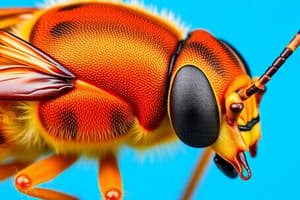Podcast
Questions and Answers
Which order includes insects commonly known as butterflies and moths?
Which order includes insects commonly known as butterflies and moths?
- Lepidoptera (correct)
- Hemiptera
- Orthoptera
- Coleoptera
What is the largest order of insects?
What is the largest order of insects?
Coleoptera
What is the common name for insects in the order Dermaptera?
What is the common name for insects in the order Dermaptera?
- Cockroaches
- Praying Mantids
- Earwigs (correct)
- Grasshoppers
What is a distinguishing feature of the order Hemiptera?
What is a distinguishing feature of the order Hemiptera?
Orthoptera means 'straight wing'.
Orthoptera means 'straight wing'.
Match the following insect orders with their common names:
Match the following insect orders with their common names:
What type of mouthparts do members of the order Anoplura have?
What type of mouthparts do members of the order Anoplura have?
Which order is known for having a triangular head that is broader than the thorax?
Which order is known for having a triangular head that is broader than the thorax?
What is the common name for insects in the order Siphonaptera?
What is the common name for insects in the order Siphonaptera?
What type of metamorphosis do members of the order Collembola undergo?
What type of metamorphosis do members of the order Collembola undergo?
Flashcards are hidden until you start studying
Study Notes
Lepidoptera
- Four membranous wings; hindwings smaller than forewings.
- Mainly covered with scales; mouthparts adapted for sucking.
- Some adults lack mouthparts and do not feed.
Coleoptera
- Largest insect order, with around 300,000 to over a million species.
- Highly variable size, with the heaviest insects being beetles.
- Four pairs of wings, forewings thickened as elytra covering membranous hindwings.
- Includes diverse habits, with predators like ladybird beetles.
Dermaptera
- Name translates to "skin wing."
- Exhibits gradual metamorphosis.
- Characterized by two pairs of wings, with the front one often reduced and leathery.
- Chewing mouthparts; mostly omnivorous with forceps-like cerci.
- Some species are considered nuisance pests.
Hemiptera
- Known as true bugs; presence of thick front wings and membranous hind wings.
- Triangular structures on the back; pentamerous antennae.
- Features piercing or sucking mouthparts and incomplete metamorphosis.
- Examples include bed bugs and chinch bugs.
Orthoptera
- Name means "straight wing."
- Shows gradual metamorphosis with leathery forewings.
- Possesses chewing mouthparts; hind legs adapted for jumping.
- Mainly phytophagous and capable of sound production using the tympanal organ.
Mantodea
- Name translates to "soothsayer" or "prophet."
- Possesses gradual metamorphosis; forewings are leathery.
- Equipped with chewing mouthparts and predatory raptorial front legs.
- Reproduces by laying eggs in ootheca.
Blattodea
- Derived from the Greek word "blatta" meaning cockroach.
- Features gradual metamorphosis and usually leathery wings.
- Chewing mouthparts and primarily omnivorous; cursorial legs for speed.
- Some species exhibit social behavior; eggs laid in ootheca.
Phasmatodea
- Name means "apparition" or "phantom."
- Exhibits gradual metamorphosis with reduced or absent wings.
- Foliage feeders with a cryptic appearance, often nocturnal.
- Sexually dimorphic species that can reproduce parthenogenetically; regenerative capabilities.
Odonata
- Name means "tooth," indicating predatory nature.
- Undergoes incomplete metamorphosis; aquatic naiads.
- Two pairs of elongated wings with complex venation; chewing mouthparts.
- Both naiads and adults are predatory; males of the species are territorial.
Siphonaptera
- Characterized by a short lifespan and not highly diverse.
- Considered primitive, appearing early in the fossil record.
- Lifecycle includes larva, pupa, and adult stages; known to spread diseases.
Mallophaga
- Encompasses around 2,600 species of chewing lice.
- Features a triangular head broader than the thorax and a flattened body.
- Simple metamorphosis; ectoparasitic, feeding on skin or feathers.
- Transmitted through contact with other animals.
Anoplura
- Includes around 2,400 species of wingless ectoparasites with sucking mouthparts.
- Smaller size, flattened body, reduced eyes, and clawlike tarsi for gripping.
- Exhibits incomplete metamorphosis, with strong host specificity (mammals only).
Collembola
- Named for the collophore; small, primitive hexapods.
- No metamorphosis; adults continue to molt.
- Primitively wingless with chewing mouthparts.
- Capable of jumping using furcula and tenaculum; primarily feed on fungi, common in soil and leaf litter.
Diplura
- Includes approximately 800 species; less species-rich than Collembola.
- Substantial diversity in habitat preferences and lifestyles.
Studying That Suits You
Use AI to generate personalized quizzes and flashcards to suit your learning preferences.




